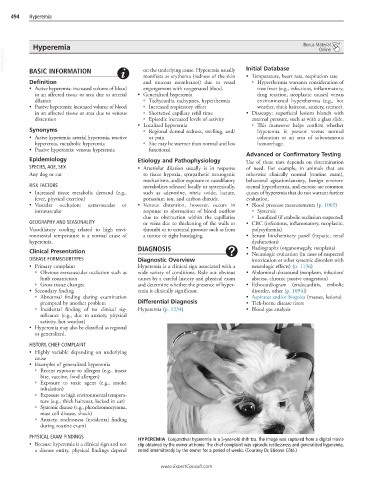Page 1005 - Cote clinical veterinary advisor dogs and cats 4th
P. 1005
494 Hyperemia
Hyperemia Bonus Material
Online
VetBooks.ir Initial Database
BASIC INFORMATION
on the underlying cause. Hyperemia usually
manifests as erythema (redness of the skin • Temperature, heart rate, respiration rate
Definition and mucous membranes) due to vessel ○ Hyperthermia warrants consideration of
• Active hyperemia: increased volume of blood engorgement with oxygenated blood. true fever (e.g., infectious, inflammatory,
in an affected tissue or area due to arterial • Generalized hyperemia drug reaction, neoplastic causes) versus
dilation ○ Tachycardia, tachypnea, hyperthermia environmental hyperthermia (e.g., hot
• Passive hyperemia: increased volume of blood ○ Increased respiratory effort weather, thick haircoat, anxiety, tremor).
in an affected tissue or area due to venous ○ Shortened capillary refill time • Diascopy: superficial lesions blanch with
distention ○ Episodic increased levels of activity external pressure, such as with a glass slide.
• Localized hyperemia ○ This maneuver helps confirm whether
Synonyms ○ Regional dermal redness, swelling, and/ hyperemia is present versus normal
• Active hyperemia: arterial hyperemia, reactive or pain coloration or an area of subcutaneous
hyperemia, metabolic hyperemia ○ Site may be warmer than normal and less hemorrhage.
• Passive hyperemia: venous hyperemia functional
Advanced or Confirmatory Testing
Epidemiology Etiology and Pathophysiology Use of these tests depends on determination
SPECIES, AGE, SEX • Arteriolar dilation usually is in response of need. For example, in animals that are
Any dog or cat to tissue hypoxia, sympathetic neurogenic otherwise clinically normal (routine exam),
mechanisms, and/or exposure to vasodilatory behavioral agitation/anxiety, benign environ-
RISK FACTORS metabolites released locally or systemically, mental hyperthermia, and exercise are common
• Increased tissue metabolic demand (e.g., such as adenosine, nitric oxide, lactate, causes of hyperemia that do not warrant further
fever, physical exertion) potassium ion, and carbon dioxide. evaluation.
• Vascular occlusion: extravascular or • Venous distention, however, occurs in • Blood pressure measurements (p. 1065)
intravascular response to obstruction of blood outflow ○ Systemic
due to obstruction within the capillaries ○ Localized (if embolic occlusion suspected)
GEOGRAPHY AND SEASONALITY or veins due to thickening of the walls or • CBC (infectious, inflammatory, neoplastic,
Vasodilatory cooling related to high envi- thrombi or to external pressure such as from polycythemia)
ronmental temperature is a normal cause of a tumor or tight bandaging. • Serum biochemistry panel (hepatic, renal
hyperemia. dysfunction)
Clinical Presentation DIAGNOSIS • Radiographs (organomegaly, neoplasia)
• Neurologic evaluation (in cases of suspected
DISEASE FORMS/SUBTYPES Diagnostic Overview intoxication or other systemic disorders with
• Primary complaint Hyperemia is a clinical sign associated with a neurologic effects) (p. 1136)
○ Obvious extravascular occlusion such as wide variety of conditions. Rule out obvious • Abdominal ultrasound (neoplasm, infection/
limb constriction causes by a careful history and physical exam abscess, chronic passive congestion)
○ Gross tissue changes and determine whether the presence of hyper- • Echocardiogram (endocarditis, embolic
• Secondary finding emia is clinically significant. disorder, other [p. 1094])
○ Abnormal finding during examination • Aspirates and/or biopsies (masses, lesions)
prompted by another problem Differential Diagnosis • Tick-borne disease titers
○ Incidental finding of no clinical sig- Hyperemia (p. 1234) • Blood gas analysis
nificance (e.g., due to anxiety, physical
activity, hot weather)
• Hyperemia may also be classified as regional
or generalized.
HISTORY, CHIEF COMPLAINT
• Highly variable depending on underlying
cause
• Examples of generalized hyperemia
○ Recent exposure to allergen (e.g., insect
bite, vaccine, food allergen)
○ Exposure to toxic agent (e.g., smoke
inhalation)
○ Exposure to high environmental tempera-
ture (e.g., thick haircoat, locked in car)
○ Systemic disease (e.g., pheochromocytoma,
mast cell disease, shock)
○ Anxiety, restlessness (incidental finding
during routine exam)
PHYSICAL EXAM FINDINGS HYPEREMIA Conjunctival hyperemia in a 5-year-old shih tzu. The image was captured from a digital movie
• Because hyperemia is a clinical sign and not clip obtained by the owner at home. The chief complaint was episodic restlessness and generalized hyperemia,
a disease entity, physical findings depend noted intermittently by the owner for a period of weeks. (Courtesy Dr. Etienne Côté.)
www.ExpertConsult.com

